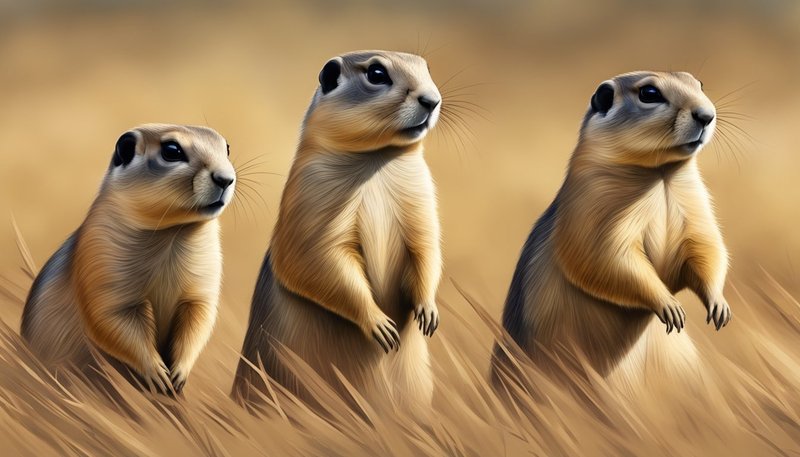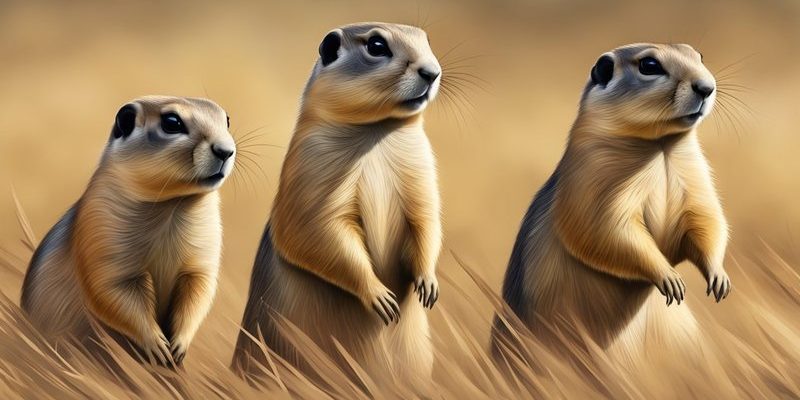
Prairie dogs are intriguing creatures, often depicted as adorable little furballs, but they play a crucial role in their habitat. They’re not just grazing on grass; their diet and hunting strategies have a direct impact on the prairie environment. Picture this: a prairie dog sharing its meal with the rest of its family, all while keeping an eye out for potential predators. It’s a fascinating dance of survival that we’ll explore in detail.
Understanding Prairie Dog Diet
Prairie dogs are primarily herbivores, which means they mainly eat plants. But their diet isn’t limited to just one type of vegetation. They enjoy a variety of foods, much like a buffet, which allows them to thrive in their environment.
- Grasses: These are the staple of a prairie dog’s diet. They typically consume several species, including blue grama and buffalo grass, which are plentiful in their habitat.
- Seeds: Prairie dogs also munch on seeds found in the wild, which are packed with nutrients and energy.
- Flowers and Roots: During different seasons, they might snack on wildflowers and even dig up roots to find something tasty.
You might wonder why such a varied diet is important. Well, it helps prairie dogs maintain a balanced nutritional intake. In the wild, they need to be nimble and quick to avoid predators while ensuring they have the energy to forage and dig. Their diverse eating habits also help maintain the health of the grasslands by preventing any single plant species from dominating.
How Prairie Dogs Forage for Food
Foraging is a vital part of a prairie dog’s life, and they have some pretty clever strategies up their sleeves. Unlike many animals that may spend hours searching for food, prairie dogs have developed some effective methods to maximize their foraging efficiency.
When prairie dogs go food hunting, they often do it in groups. This way, they can take advantage of safety in numbers. As they venture out of their burrows, some prairie dogs act as lookouts while others forage. This is a bit like having a buddy system in school; it just makes everything safer and more efficient.
Here’s a fun fact: prairie dogs have strong social structures. They communicate with each other using a variety of barks and calls. These vocalizations can actually alert others about potential threats or point out the best grazing spots. Isn’t it impressive how wildlife has its own version of teamwork?
The Role of Predators in Their Hunting Strategies
Even with their excellent foraging techniques, prairie dogs must always be cautious. Their diet and hunting strategies are closely linked to the presence of predators in their environment. Common predators include hawks, coyotes, and badgers—all of which are on the lookout for a prairie dog snack.
To counteract this threat, prairie dogs have developed some fascinating behavioral adaptations. Their alert system is finely tuned. If a prairie dog spots a predator, it will make a distinct warning noise that sends the entire colony into a frenzy. They quickly retreat to their burrows, where they can hide and stay safe. This communal approach shows how collaboration plays a critical role in their survival.
Interestingly, prairie dogs also create a series of tunnels that serve multiple purposes. Not only do these tunnels sneakily lead to their homes, but they also provide escape routes. These underground networks are like their personal highways, facilitating movement while keeping them shielded from danger.
Seasonal Changes in Diet
As the seasons change, so does the prairie dog’s diet. In spring and summer, their menu is rich and varied, featuring freshly sprouted grass. But come fall and winter, things change quite dramatically.
During the colder months, prairie dogs rely on stored food. They gather and stash away seeds and dried grass during the warmer seasons. Imagine making a winter pantry filled with goodies—that’s precisely what they do! This behavior ensures they have enough to eat when harsh conditions make foraging difficult.
Additionally, in winter, prairie dogs enter a state of torpor, which is similar to hibernation but not as deep. This means they may stay in their burrows for extended periods, reducing their need for food while conserving energy. It’s a smart strategy to cope with the scarcity of available food.
How Prairie Dogs Impact Their Ecosystem
Prairie dogs are not just cute animals; they play a pivotal role in the ecosystem of the grasslands. By digging their extensive burrows, they aerate the soil, which helps promote healthy plant growth. This tunneling activity can change the very structure of the land, allowing water and nutrients to penetrate deeper into the ground.
Additionally, their presence creates habitats for other animals. When prairie dogs dig their burrows, they inadvertently provide homes for a variety of species like foxes, burrowing owls, and even some insects. This interdependence highlights the importance of prairie dogs in maintaining biodiversity within their habitat.
Moreover, prairie dogs are often called a “keystone species.” This means their activities have a disproportionately large effect on their environment. Without prairie dogs, the dynamics of the prairie ecosystem could shift dramatically, leading to fewer plant species and an overall decline in wildlife.
Conservation Challenges Facing Prairie Dogs
Despite their importance, prairie dog populations face numerous challenges. Urban development, agriculture, and pest control measures have significantly reduced their habitats. Honestly, it’s a bit heartbreaking when you see how these little creatures are squeezed into smaller and smaller spaces.
Another issue is the spread of diseases, such as the plague, which can devastate prairie dog colonies. This can greatly impact the balance of the ecosystem and lead to declines in other species that rely on them.
Conservation efforts are vital to ensuring that prairie dogs continue to thrive. Protected areas and wildlife reserves can provide safe havens for these animals, allowing them to flourish and maintain their essential role in the ecosystem. Community education about the importance of prairie dogs can also foster a greater appreciation for these fascinating creatures and their habitats.
In summary, the diet and hunting strategies of prairie dogs are as complex and rich as the ecosystems they inhabit. From their varied plant-based diet to their clever foraging tactics, these little critters do an impressive job of surviving in the wild. The way they interact with their environment and contribute to the ecosystem is a testament to the marvel of nature.
By understanding the life of prairie dogs, we see just how interconnected all species are. Their presence not only supports their colonies but also enables other wildlife to thrive. So, the next time you think of the beautiful expanses of the prairie, remember the prairie dog, an essential player in that vibrant landscape.

